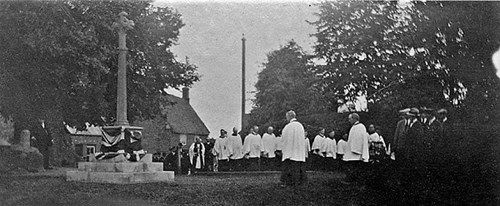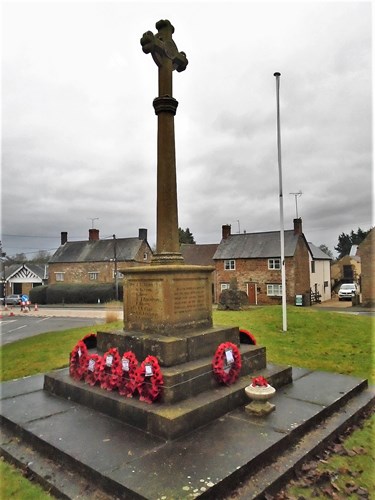From The Northampton Daily Echo, September 1920…
HEROES OF BYFIELD
SIR RYLAND ADKINS’ TRIBUTE
WAR MEMORIAL UNVEILED
Byfield’s War memorial, a graceful cross erected upon the most historic spot in the village, was unveiled in the presence of a large assembly on Friday September 10th evening by Sir Ryland Adkins, K.C., M.P., chairman of the Northants County Council.

The memorial has been raised by public subscription, and the committees responsible are to be complimented upon the manner in which they have ensured that the memories of the heroes of the village shall remain green. The cross, which rises to a height of 14 feet, stands upon the crest of a natural mound in the village and in close proximity to the old market cross, and beneath an elm tree that was planted in 1753.
Web Editor's Note: Subsequently the whole memorial was moved a few metres to the right (of the site in the picture above) and back from the brink (of the slope to the road) due to the old elm's roots lifting its base. Then, later still, sadly a little after its 200th birthday, the ancient elm known as "the Cross Tree" had to be removed completely. Below are two pictures, one taken before the war and one in November 2018, the latter from a similar angle as the black and white photo of the unveiling above; the medieval market stone is still there, and can be seen in the left foreground. Time Capsule? When the old elm's roots were dug-out, Byfield's school children prepared and buried a Time Capsule where the old tree had been. Finding it again would be a real tresure hunt.


AN IMPOSING ERECTION
The preparation of the design was entrusted to Mr. George M. Weldren of Northampton, whose labours have resulted in an imposing and well proportioned memorial, based on best traditions. He has wisely adopted the Early English style, which lends itself so well to these village crosses. The cross has a solid square moulded base raised upon three massive steps, square on plan, upon which rests the octagonal shaft, with base mould and an effective moulded cap.
Above this rises the cross proper, in the centre of which, carved on both sides, stands out in bold relief, the sacred emblem I.H.S.* The steps are of blue Hornton stone and the remainder of the structure is of selected brown Horton – a local stone of subdued and pleasing tint.
The work was executed by Messrs. S.L. Reynolds and Son, sculptors and carvers, of Northampton and is a fine example of artistic workmanship.
On the panel of the base facing the road is the following Dedication, beautifully cut in bold Church Text, surmounted by a cross:- “To the Glory of God, and in Grateful Memory of those of this Village who fell in the Great War, 1914-1919.”
On the side panels are evenly distributed the names of the fallen, viz.:- Pte. J.A. Allen, Pte. H. Barton, Pte. A. Bent, Pte. T. H. Brightwell, Pte. F. Brown, Lce.-Cpl. T.E. Cary, Pte. W.G. Fenemore, Pt. E. Gardner, Cpl. P.D. Gibbs, Pte. W.H. Jennings, Pte. J. Newcombe, Lieut. A.E. Sedgwick, Pte. H. Sedgwick, Cpl. W.G. Smith M.M., Pte. S. Wiggins, Cpl. V.J. Wilkins.
Recorded on the back panel is:- “Also in appreciation of the splendid services of those who, having taken their part in the great struggle, have returned to their homes and friends.”
At the unveiling ceremony, the Rev. E. T. Sanders introduced Sir Ryland Adkins. The committee had taken a wise step in asking him, for as chairman of the County Council, Sir Ryland was representative of the whole county, and he was a Northamptonshire man, and yielded to no one in his love for Northamptonshire. Some people might think they ought to have asked a military person to perform the ceremony, but he would remind them that for years Sir Ryland had taken a deep interest in the Territorial movement in the county.**
BYFIELD AND OLDEN WARS
After Sir Ryland Adkins had unveiled the cross, dedicatory prayers were recited by the Vicar, the Rev. G.T. Charlesworth and Mr. J.T. Andrews read a portion of Scripture.
Sir Ryland Adkins said that in all the hundreds of years that have passed since men came to live in Byfield there had been no time so great, no event had happened of equal consequence to the times we now lived in and the great world-shaking event, the war, which was now passed. Nearly 1,400 years had gone since the group of Saxon farmers put their homesteads together and made that village on the place and not altogether unlike what they saw it now. Within three or four generations after that or but a little more, there began in that place the worship of the White Christ, which had never failed since, and which they had already taken a share in that day.
From that far-off time till now many had been the days when fear and bloodshed and terror had touched the lives of those who spent their time and their toil there. The Dane had come with fire and the Norman had pressed his iron heel on the countryside. There had been wars where Englishmen strove with Englishmen and the battle of the Barons’ War over at Edgecote – Loosecoats Field as it was called. That was known and felt at Byfield. Long after that, less than three centuries ago, there came the tramp of armed men on their way to Naseby Field. While the men, women and children in all those times of crisis and terror wondered if anything could be worse or more terrible, they knew now that none of those days were so full of anxiety and risk to the life and future of English people as were those of the great war now happily ended in triumph.
Whether one side or the other had won in those olden days he thought the gradual slow growth of England, there and elsewhere, would have gone on, but had our country fallen in the great war there would have been an end of the way of living of a great self-governing country which had only grown up into its strength in a thousand years. As it had pleased God that they should live in these most searching times, so was it for them to see that those whom they had known and who were called to fight for them and for their country in that by far the greatest of its perils, it was for them to see that such were held in honour and that they did not let them fade from their minds, or their feelings about them grow less warm in their hearts.
JUST ORDINARY FOLK
They were not picked men trained to fight, but just like the rest of them, plain folk going about their work from day to day, but to them came the greatest of all calls and they responded to it for them, for England, for freedom, and for right. They went without long preparation, never having thought in their lives that that would be their end. Had they not taught those who remained that there was placed upon them, in the mysterious providence of God, the duty of defending their country at all times.
Did they not learn from what those men did to hate war more than ever, and yet to be ready to die, as they did, for the things that made life worth living? In the long years of peace they had dreamed that war was over, that what they had to do to those they loved, to those amongst whom they lived, to their parish, to their county, and to England hardly took in the duties of training and of national defence. They could think so no longer. Now they knew that so long as man was in the world there was the danger of war breaking out. They had indeed to do all they could to prevent it coming in their time, and in the time after their time. They had to defend our country not by heaping up things which might provoke war, but by strength of will by doing their full duty as citizens and Englishfolk, and by bearing in mind the example those men had set them in that great task.
Sapper J. Tomalin R.E. sounded the “Last Post”.
Mr. W.H. Potter proposed a vote of thanks to Sir Ryland Adkins, whose impressive address would make them look upon that sacred column in its great reality, - Mr. F. Turvey seconded.
Sir Ryland Adkins, in reply, voiced thanks to the chairman of the committee, the Rev. E.T. Sanders, C.C., the secretary, Mr. J.T. Andrews and the treasurer Mr. J. Jones, for their untiring work in bringing to such a successful issue that great and solemn commemoration. Mr. W. J. Sedgewick seconded.
Web Editor's additional notes:
*I.H.S. equates to “Jesus” (a Christogram or Holy Name - after translations from Greek to Latin)
** At the outbreak of the First World War, Britain’s Army were all volunteers. Many were part of a “Territorial” or county by county “Yeomanry” Regiment.
The peace after that terrible war did not last and not twenty-five years later more men, and women from Byfield fell in the next great conflict. Their names were subsequently added to our Memorial.
In the latter part of the 20th century and the first few years of the 21st, Byfield's War Memorial and its surrounds won the County's competition for "best kept" nearly a dozen times. Unfortunately since then green fingers have become a rarity amongst us, now as long as its tidy, we are content.
Below Byfield's War memorial in 2018
